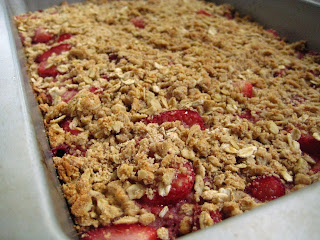 This month there is a food event for Weekend Breakfast Blogging that calls for Balanced Breakfast Meals. To be considered balanced, the guidelines encourage us to use more than one of these four food groups: fruits/vegetables, grains/cereals, dairy, vegetarian proteins.
This month there is a food event for Weekend Breakfast Blogging that calls for Balanced Breakfast Meals. To be considered balanced, the guidelines encourage us to use more than one of these four food groups: fruits/vegetables, grains/cereals, dairy, vegetarian proteins.
I am providing four hearty protein-packed vegetarian breakfasts that include all four of the food groups. They are all very easy to make using leftovers, so why wait for the weekend to make these wholesome morning meals?

Number One: Scrambled Eggs with Spinach, Roasted Red Pepper, Mozzarella and Wholegrain Bread
Protein: Eggs, Whole grains in the bread, Cheese
Grains: Whole grain bread
Dairy: Cheese, Butter (on bread)
Fruits/Vegetables: Red Bell Pepper, Spinach

Number Two: Veggie Melt: Wholegrain Toast topped with Tomatoes, Spinach and Cheese
Protein: Cheese, Whole grains in bread
Grains: Whole Grain Bread
Dairy: Cheese
Fruits/Vegetables: Tomatoes, Spinach

Number Three: Enfrijolada topped with Fried Eggs, Onion, Cilantro, and Queso Fresco
To make enfrijoladas: Warm corn tortillas. Warm some refried black beans or pinto beans and thin them out with a bit of water. Dip the tortillas into the beans to coat them completely. Then fold them or roll them. Top them or fill them as shown or with whatever you have on hand. Some suggestions are salsa, chopped tomatoes, cream, jalapeno or serrano chile strips...
Protein: Black beans, eggs, corn in tortillas, cheese
Grains: Corn tortillas
Dairy: Cheese (queso fresco)
Fruits/Vegetables: Onion, Cilantro, Lime juice generously coating everything

Number Four: Moyete with Fried Egg and Grape Tomatoes
Note: Moyetes are slices of bread with refried beans and cheese and sometimes other toppings that are baked in the oven until the cheese melts and the beans warm. Sometimes they also have a tomato sauce or hot chiles, etc.
Protein: Black beans, egg, cheese
Grains: Whole grain bread
Dairy: Cheese
Fruits/Vegetables: Tomatoes, Serrano chiles












 It's amazing how sweet, soft and flavorful even brioche can be using no white flour or sugar. DH used agave nectar in place of the sugar in these recipes. I can see why loaves of high quality breads cost so much money here in the States. If we were to sell the brioche, for example, we would have to charge a steep price just to break even for the cost of the ingredients, not to mention the time and energy required. But that is why it is art. I am happy and so very lucky that DH has developed such a passion for bread baking.
It's amazing how sweet, soft and flavorful even brioche can be using no white flour or sugar. DH used agave nectar in place of the sugar in these recipes. I can see why loaves of high quality breads cost so much money here in the States. If we were to sell the brioche, for example, we would have to charge a steep price just to break even for the cost of the ingredients, not to mention the time and energy required. But that is why it is art. I am happy and so very lucky that DH has developed such a passion for bread baking.


































 Italians have oregano and the French have Herbes de Provence. In the Yucatan it is epazote that gives its dishes its special flavor. Black beans are almost always cooked with epazote.
Italians have oregano and the French have Herbes de Provence. In the Yucatan it is epazote that gives its dishes its special flavor. Black beans are almost always cooked with epazote.